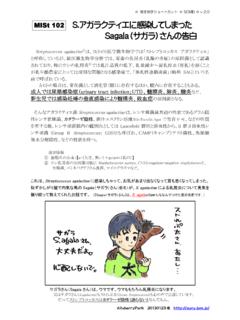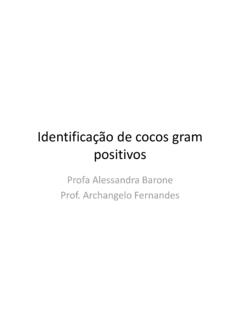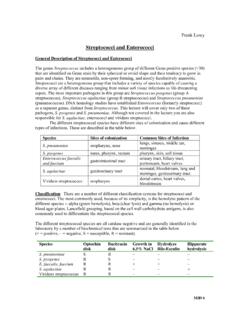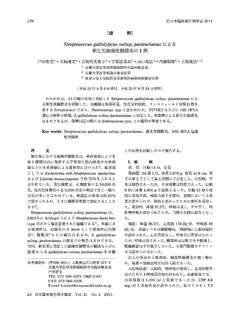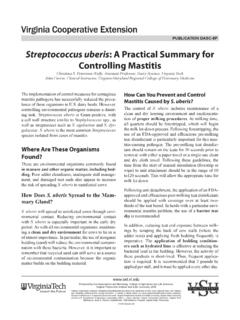Transcription of Minimum inhibitory concentrations of antimicrobials ...
1 Diseases in Asian Aquaculture VII309 Maisak, H., Tipmongkolsilp, N. and Wongtavatchai, J. 2011. Minimum inhibitory concentrations of antimicrobials against clinical Vibrio and streptococcus isolated from aquaculture, pp. 309-316. In Bondad-Reantaso, , Jones, , Corsin, F. and Aoki, T. (eds.). Diseases in Asian Aquaculture VII. Fish Health Section, Asian Fisheries Society, Selangor, Malaysia. 385 pp. Corresponding author: Janenuj Wongtavatchai, inhibitory concentrations of antimicrobials against clinical Vibrio and streptococcus isolated from aquacultureHATHAIRAT MAISAK, NUTCHARNART TIPMONGKOLSILP and JANENUJ WONGTAVATCHAID epartment of Veterinary Medicine, Faculty of Veterinary Science Chulalongkorn University, Bangkok 10330, ThailandABSTRACTFour antimicrobial agents.
2 Amoxycillin, Oxytetracycline, Sulfadiazine/Trimethoprim (SXT) and Sulfadimethoxine/Ormetoprim (ORS) were tested for their in vitro antimicrobial activity against clinical streptococcus and Vibrio isolates from clinical cases occurring between 2005 to 2006. The specimens or moribund animals from different culture areas in Thailand were collected for laboratory microbiological analysis. streptococcus strains were isolated from the kidney of the diseased tilapia Oreochromis niloticus and Vibrio strains were obtained from the hepatopancreas of diseased black tiger shrimp Penaeus monodon or pacific white shrimp Litopeneaus vannamei.
3 All clinical bacterial isolates were identified by conventional tube media or API system (Biomerieux, France). The agar dilution method, as described by the Clinical and Laboratory Standards Institute (CLSI), was used to determine Minimum inhibitory concentrations (MICs) of each chemical against the tested isolates. The effect of the components of seawater on the antimicrobial activity of ORS was also analysed by a comparison between MIC values tested on Mueller Hinton Agar (MHA) dissolved in distilled water with an added 1% NaCl and on agar dissolved in 10 ppt seawater. MIC values suggested that streptococcus isolates obtained from the diseased tilapia were resistant to Oxytetracycline (MIC range g/ml) but susceptible to Amoxicillin (MIC range g/ml), STX (MIC range g/ml) and ORS (MIC range g/ml).
4 While the test conducted against Vibrio isolates revealed broader MIC ranges; Amoxicillin g/ml, Oxytetracycline g/ml, STX >152/8 g/ml and ORS 008- >152/8 g/ml, the activity of ORS was not substantially influenced by an addition of 10 ppt seawater to the tested system..The study concluded that, in respect of MIC testing and the possible implications of a seawater effect, ORS is a functional antimicrobial for the tilapia streptococcus and penaeid shrimp Vibrio et : Minimum inhibitory concentrations , antimicrobials , streptococcus spp., Vibrio diseases are considered to be the most important cause of mass mortality and economic loss when present in intensive aquaculture.
5 Antimicrobial therapy is one of the strategies frequently applied to control bacterial diseases. As part of the prudent use of animal antimicrobials , antimicrobial susceptibility testing is strongly recommended prior to treatment. The aim of this study was to determine the Minimum inhibitory concentrations (MICs) for 4 antimicrobial agents: Amoxycillin, Oxytetracycline, Sulphadiazine/Trimethoprim (SXT) and Sulfadimethoxine/Ormetoprim (ORS) against Vibrio isolated from diseased Black Tiger shrimp (Penaeus monodon) and Pacific White shrimp (Penaeus vannamei), and streptococcus isolated from diseased tilapia (Oreochromis nilotica) in Thailand.
6 The MIC tests reveal the antimicrobial susceptibility of bacterial pathogens associated with the aquaculture industry of Thailand and hence, provide data to direct the prudent use of antimicrobials in aquaculture AND METHODSB acterial StrainsTest strain: Fifty four streptococcus spp. isolates were derived from tilapia from disease cases occurring between 2005 and 2006. Streptococcosis has been observed in most regions of tilapia farming; in the north-eastern, eastern and central parts of Thailand. Isolates were identified by conventional biochemical methods described in the API system (BioMerieux, Marcy l Etoile, France).
7 Of the fifty four streptococcus strains isolated from the kidney of the diseased tilapias were 4 S. dys. equisimilis, 43 S. agalactiae, 6 S. porcinus and one streptococcus sp. All bacterial strains were stored in a maintenance broth containing 40% glycerol and supplemented with 10% fetal bovine serum, at -70 OC. Before each experiment the stored bacteria strains were transferred to Tryptic Soy Agar (TSA, Difco Laboratory, USA) supplemented with 10% sheep blood. After incubation at 30 OC for 18-24 hr, the inocula were transferred to Tryptic Soy Broth and the cell density was adjusted to McFarland standard or approximately 108 Colony Forming Unit (CFU)/ml.
8 The inocula were then diluted ten-fold in sterile normal saline, giving a final cell density of approximately 107 isolates derived from clinical cases of diseased penaeid shrimp were obtained from the culture collection of the Department of Medicine, Faculty of Veterinary Science, Chulalongkorn University, Thailand. The collection has culture specimens from disease cases occurring between 2004 and 2006, mainly from the western and southern parts of Thailand. Previously, the identification of the isolates had been performed using conventional biochemical methods described in the API system (BioMerieux, France).
9 Of the fifty Vibrio strains isolated from the hepatopancreas of the diseased penaeid shrimp were Minimum inhibitory concentrations of antimicrobials against clinical Vibrio and streptococcus isolated from aquaculture3114 V. alginolyticus, 7 V. cholerae, 7 V. damsela, 14 V. fluvialis, 10 V. parahaemolyticus and 8 V. vulnificus strains. All bacteria strains were stored in a maintenance broth containing 40% glycerol, at -70 OC. The isolates were treated with similar procedures described for streptococcal isolates, but 1%NaCl was added to Tryptic Soy control strains: Additional bacterial organisms were obtained from the American Type Culture Collection for use as quality controls: Esteriachia coli ATCC 25922, Staphylococcus aureus ATCC 25923 and V.
10 Parahaemolyticus ATCC AgentsThe antimicrobials that were tested were Amoxicillin, Oxytetracycline, Sulfadiazine, Trimethoprim (Sigma Chemical Co., USA.), Sulfadimethoxine and Ormetoprim (PHARMAQ, St Louis, MO, Norway). A serial two-fold dilution of antimicrobials dissolved in solvent was processed with distilled water, except that Trimethoprim and Ormetoprim were dissolved in solvent only as suggested by CLSI, giving a series of tested inhibitory Concentration (MIC)The procedures described here are in accordance with the international recommendations provided by the Clinical and Laboratory Standards Institute (CLSI).


